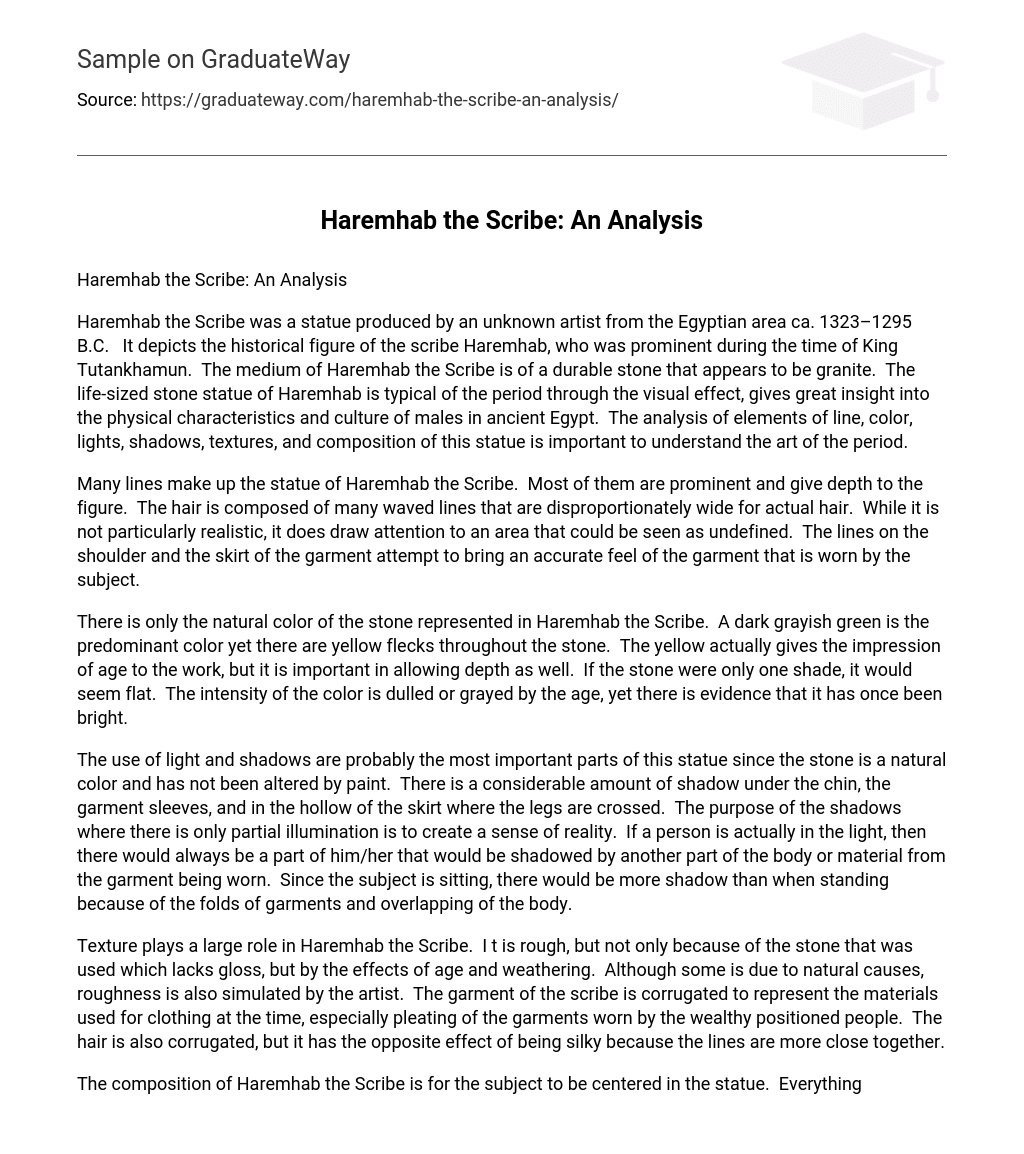Haremhab the Scribe was a statue produced by an unknown artist from the Egyptian area ca. 1323–1295 B.C. It depicts the historical figure of the scribe Haremhab, who was prominent during the time of King Tutankhamun. The medium of Haremhab the Scribe is of a durable stone that appears to be granite. The life-sized stone statue of Haremhab is typical of the period through the visual effect, gives great insight into the physical characteristics and culture of males in ancient Egypt. The analysis of elements of line, color, lights, shadows, textures, and composition of this statue is important to understand the art of the period.
Many lines make up the statue of Haremhab the Scribe. Most of them are prominent and give depth to the figure. The hair is composed of many waved lines that are disproportionately wide for actual hair. While it is not particularly realistic, it does draw attention to an area that could be seen as undefined. The lines on the shoulder and the skirt of the garment attempt to bring an accurate feel of the garment that is worn by the subject.
There is only the natural color of the stone represented in Haremhab the Scribe. A dark grayish green is the predominant color yet there are yellow flecks throughout the stone. The yellow actually gives the impression of age to the work, but it is important in allowing depth as well. If the stone were only one shade, it would seem flat. The intensity of the color is dulled or grayed by the age, yet there is evidence that it has once been bright.
The use of light and shadows are probably the most important parts of this statue since the stone is a natural color and has not been altered by paint. There is a considerable amount of shadow under the chin, the garment sleeves, and in the hollow of the skirt where the legs are crossed. The purpose of the shadows where there is only partial illumination is to create a sense of reality. If a person is actually in the light, then there would always be a part of him/her that would be shadowed by another part of the body or material from the garment being worn. Since the subject is sitting, there would be more shadow than when standing because of the folds of garments and overlapping of the body.
Texture plays a large role in Haremhab the Scribe. I t is rough, but not only because of the stone that was used which lacks gloss, but by the effects of age and weathering. Although some is due to natural causes, roughness is also simulated by the artist. The garment of the scribe is corrugated to represent the materials used for clothing at the time, especially pleating of the garments worn by the wealthy positioned people. The hair is also corrugated, but it has the opposite effect of being silky because the lines are more close together.
The composition of Haremhab the Scribe is for the subject to be centered in the statue. Everything about the subject is facing forward except for the legs which are drawn under him. However, that would be realistic for the time since he would not have ordinarily sat on a chair. The eyes stare out at the viewer and the head is also in the straight forward position. The arms are close to the subject’s side to the elbow and then they reach forward. The scroll on which he has written the history of his king is also thrust forward.
The analysis of line, color, light, shadow, texture, and composition have provided the information for the understanding of the statue Haremhab the Scribe. The statue from ancient Egypt has many elements to share with the modern world as it does with the story of the scribe, but it also teaches about the tools and methods of the artist of the period and provides those in the modern world to see how far art has come, and also how advanced that they were at the time.
References
“Haremhab the Scribe.” Metropolitan Museum of Art. Retrieved September 25, 2008
from http://www.metmuseum.org/toah/hd/nking/ho_23.10.1.htm#





